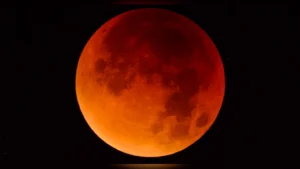Total Lunar Eclipse 2025: Witness the Stunning Blood Moon
Introduction
A rare and breathtaking celestial event is set to occur soon – the Total Lunar Eclipse 2025, popularly known as the Blood Moon. This event happens when the Earth comes directly between the Sun and the Moon, casting a shadow over the Moon’s surface. As the eclipse reaches totality, the Moon takes on a dramatic red or copper hue, giving it the nickname “Blood Moon.” For astronomy lovers and casual skywatchers alike, this is an unmissable spectacle.

What is a Total Lunar Eclipse?
A total lunar eclipse occurs when the Earth’s shadow completely covers the Moon. During this time, sunlight refracts through the Earth’s atmosphere and falls onto the Moon. Because the Earth’s atmosphere filters out blue light, only reddish wavelengths reach the Moon, turning it into a glowing red orb. Unlike solar eclipses, lunar eclipses are safe to watch with the naked eye and require no special equipment.
When Will the Total Lunar Eclipse 2025 Occur?
The upcoming total lunar eclipse is expected to take place on [Insert Exact Date & Time – e.g., September 7, 2025] (update with actual date from astronomy calendars). The eclipse will be visible from most parts of Asia, Europe, Africa, and the Americas. In India, skywatchers can see the entire phase of the eclipse from moonrise to moonset, depending on local timings.
Why is it Called a Blood Moon?
The reddish glow of the Moon during totality is due to Rayleigh scattering – the same phenomenon that makes sunsets appear red. The Earth’s atmosphere bends and scatters sunlight, and the remaining red light reaches the Moon’s surface. This eerie yet beautiful sight has earned it the nickname “Blood Moon” across cultures.
How to Watch the Blood Moon Safely
One of the best things about a lunar eclipse is that it’s safe to view with the naked eye. No protective glasses are needed (unlike a solar eclipse). However, for an enhanced view, you can use binoculars or a telescope. Choose a location away from city lights to enjoy a clearer night sky.
Tips for Watching:
- Find an open area with a clear view of the sky.
- Check the exact local time of the eclipse for your region.
- Use a camera or smartphone with a tripod to capture the event.
- Bring a blanket or chair for comfort during the viewing.
Cultural and Scientific Significance
Throughout history, lunar eclipses have been associated with myths, legends, and spiritual beliefs. In modern times, they are celebrated as educational and scientific opportunities to understand celestial mechanics. Astronomy clubs and observatories often organize public viewing events and workshops during eclipses.